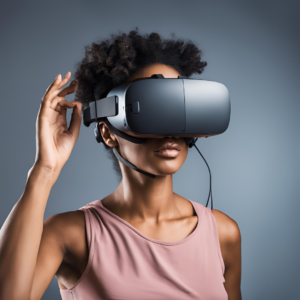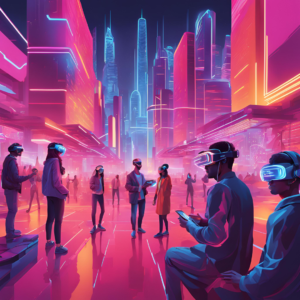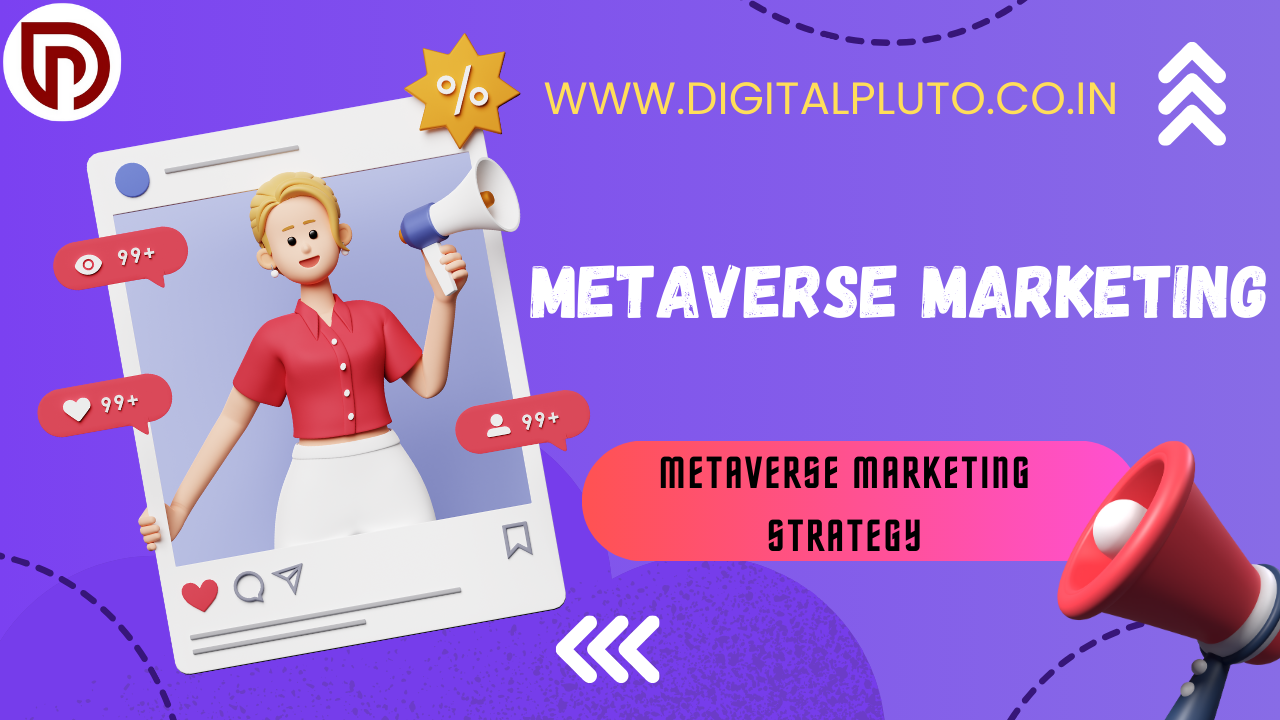
Unveiling the Immersive World of AR and VR

The domains of virtual reality (VR) and augmented reality (AR) have the potential to completely transform how we engage with the digital world in the quickly changing technology landscape of today. In addition to revolutionizing the entertainment sector, these cutting-edge technologies are also making major advancements in e-commerce, healthcare, education, and other fields. This blog post is your first step towards discovering the enormous possibilities of these fascinating career pathways by exploring AR and VR.
Understanding the Difference: AR vs. VR

Before we dive into the career opportunities in this field, it’s essential to understand the fundamental differences between Augmented Reality and Virtual Reality.
Augmented Reality (AR) is designed to enhance the real-world environment by overlaying digital elements, such as 3D models, images, or information, onto the user’s view. AR technology allows users to interact with these virtual elements seamlessly, blending the physical and digital worlds. Examples of AR applications include the popular mobile game Pokémon Go, Snapchat filters, and IKEA’s app that lets users preview furniture in their own homes.
On the other hand, Virtual Reality (VR) is an immersive experience that isolates the user from the real world by creating a completely computer-generated simulation of an alternate environment. VR typically involves the use of a headset, sensors, and headphones to provide a fully immersive experience, transporting the user to a different digital realm. VR has applications in gaming, entertainment, training, and even therapeutic interventions.
While exploring AR and VR have distinct characteristics, the industry has also seen the emergence of Mixed Reality (MR), which combines elements of both AR and VR, allowing digital objects to interact with the real-world environment. Additionally, the term Extended Reality (XR) is used to encompass all the various types of technology that enhance our senses, including AR, VR, and MR.
The Booming Future of AR and VR

The future of exploring AR and VR is undoubtedly bright, with the industry poised for exponential growth in the coming years. According to a report by Goldman Sachs, while exploring AR and VR market size is expected to reach a staggering $1.6 trillion by 2030, driven by the increasing adoption of these technologies across a wide range of industries.
This growth is fueled by the numerous applications of AR and VR, from revolutionizing the way we learn and entertain ourselves to transforming the healthcare and retail sectors. As the demand for these technologies continues to rise, so too will the need for skilled professionals to develop, design, and implement AR and VR solutions.
In-Demand AR and VR Career Opportunities
The burgeoning AR and VR industry offers a diverse range of career opportunities for individuals with the right skills and expertise. Some of the in-demand job titles in this field include:
- Software Engineers: Responsible for developing the software and applications that power AR and VR experiences, using programming languages like C++, Unity, and Unreal Engine.
- 3D Artists and Designers: Tasked with creating the immersive 3D environments, characters, and visual elements that bring AR and VR experiences to life, using tools like Maya, Blender, and Adobe Creative Suite.
- User Experience (UX) Designers: focused on designing intuitive and engaging user interfaces for AR and VR applications, ensuring seamless interactions and optimal user experiences.
- Project Managers: Responsible for overseeing the development and implementation of AR and VR projects, coordinating the efforts of cross-functional teams, and ensuring timely delivery.
- Hardware Engineers: Involved in the development and integration of the physical hardware components, such as sensors, cameras, and haptic feedback devices, that enable AR and VR experiences.
Tech behemoths like Facebook Reality Labs, Google, Microsoft, Magic Leap, Sony, Amazon, HTC, Unity Technologies, and many more are among the leading organizations currently looking for these AR and VR positions.
Salary Potential in the AR and VR Industry
The increasing need for experts in AR and VR has also resulted in lucrative employment opportunities. Industry sources indicate that an entry-level AR or VR job in India can pay somewhere between ₹8 and ₹12 lakhs annually. While highly qualified developers and those in senior jobs can earn up to $150,000 annually, the national average compensation for these individuals in the US is approximately $85,000.
The income potential for AR and VR experts is anticipated to increase as the sector develops and matures, making it a more profitable career choice for individuals with the necessary knowledge and abilities.
ex
To thrive in the dynamic world of AR and VR, professionals in this field need to possess a diverse set of skills. Here are some of the key competencies that are highly valued in the industry:
Technical Skills
- Programming and Coding: Proficiency in programming languages like C++, C#, and JavaScript, as well as familiarity with game engines like Unity and Unreal Engine.
- 3D Graphics and Modeling: Expertise in 3D modeling and animation software, such as Maya, Blender, and 3DS Max, to create the virtual environments and assets for AR and VR experiences.
- Hardware Integration: Understanding of the hardware components, sensors, and haptic feedback devices that enable AR and VR, and the ability to integrate them seamlessly with software solutions.
Creative and Design Skills
- User Experience (UX) Design: Ability to design intuitive and engaging user interfaces for AR and VR applications, ensuring seamless interactions and optimal user experiences.
- Graphic Design: Proficiency in graphic design tools and techniques to create visually appealing and immersive 2D and 3D assets for AR and VR experiences.
- Animation: Skills in creating dynamic and lifelike animations to enhance the realism and interactivity of AR and VR environments.
Problem-Solving and Analytical Skills
- Critical Thinking: Ability to identify and solve complex problems that arise during the development and implementation of AR and VR technologies, such as optimizing performance, minimizing latency, and integrating software with hardware.
- Analytical Mindset: Strong analytical skills to understand technical requirements, analyze data, and devise creative solutions to meet client needs.
Communication and Collaboration Skills
- Effective Communication: Ability to articulate ideas and concepts clearly, both verbally and in writing, to engage effectively with clients, stakeholders, and cross-functional teams.
- Teamwork and Collaboration: Capacity to work seamlessly with designers, developers, and other professionals to deliver successful AR and VR projects.
By developing a strong foundation in these key skills, aspiring AR and VR professionals can position themselves for success in this rapidly evolving industry.
Roadmap to Building a Career in AR and VR
This is a comprehensive guide to help you get started if you want to work in augmented reality or virtual reality:
Explore the Field and Gain Foundational Knowledge
Start your adventure by learning more about AR and VR through specialized programs, basic classes, and internet research. You will gain a thorough awareness of the technologies, their uses, and the most recent developments in the sector as a result.
Pursue Relevant Education and Training
A bachelor’s degree in computer science, game development, graphic arts, or a similar discipline might be a great starting point for a career in AR and VR, though it is not always necessary. Specialized programs in these cutting-edge technologies are available at numerous universities, including MIT, Stanford University, the University of Southern California, and the University of Washington.
For individuals seeking additional specialization, think about enrolling in a postgraduate program or a virtual reality specialization on websites such as Coursera. You may expand your knowledge and acquire specific skills in fields like hardware integration, AR/VR programming, and Unity 3D development with the aid of these advanced programs.
Gain Practical Experience through Internships and Projects

Look for internships with research laboratories, game development studios, or AR/VR businesses to construct a solid portfolio and obtain practical experience. These chances will give you the chance to pick the brains of seasoned experts and put your abilities to use in practical situations.
Additionally, to demonstrate your creative and problem-solving skills, think about taking on freelance or personal projects. When looking for freelance work and developing your portfolio, platforms such as Fiverr can be a wonderful place to start.
Stay Up-to-Date with Industry Trends and Developments

The AR and VR landscape is constantly evolving, so it’s crucial to stay informed about the latest technologies, tools, and industry trends. Regularly attend industry events, conferences, and meetups, and follow influential thought leaders and industry publications to keep your knowledge and skills sharp.
By following this roadmap and continuously learning and adapting, you can position yourself for a rewarding and fulfilling career in the exciting world of Augmented Reality and Virtual Reality.
Unlock Your Potential in the AR and VR Industry
Unquestionably, augmented reality and virtual reality have a bright future ahead of them, with a wide range of opportunities for qualified workers. There are many opportunities to explore and succeed in the exploring AR and VR industries, regardless of your passion: software engineering, 3D design, user experience, or project management.
You can open up a world of opportunities and start a rewarding career in this quickly changing and revolutionary field by honing the technical, creative, and problem-solving skills you need and keeping up with the most recent developments. What are you waiting for, then? Begin your path to a fascinating and fulfilling profession in virtual and augmented reality right now!
Follow https://www.digitalpluto.co.in/ for more latest updates about graphic design.






